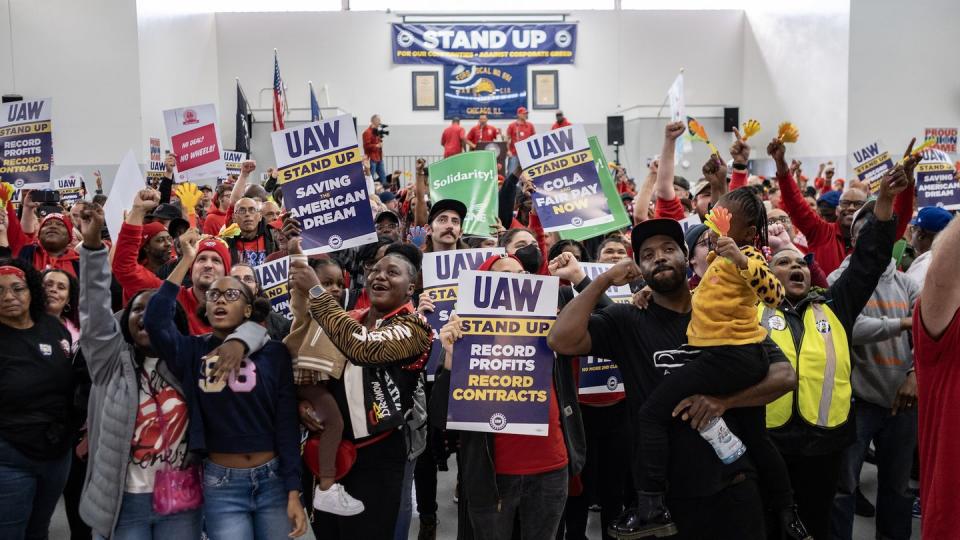UAW Ratifies New Contracts, with New-Car Prices Predicted to Rise

After two brutal months of posturing, negotiations, and work stoppages designed to inflict maximum pain, the 2023 United Auto Workers (UAW) strike against Ford, General Motors, and Stellantis has finally ended.
UAW president Shawn Fain first announced a tentative agreement with Ford on October 25. Stellantis followed suit a few days later, followed finally by General Motors on October 30. With UAW members voting to accept the deals last week, the strike is now officially over. At 46 days, it is the longest UAW action since 1998's strike against GM.
The Ford contract cleared first, with 69 percent of workers voting in favor of the agreement. Stellantis bettered that with 70 percent voting in favor, but GM's barely passed. Just 55 percent voted in favor.
The Road to New Contracts
The deals for all three are broadly the same, including wage increases and cost-of-living adjustments that will result in greater than 30 percent boosts in pay over the next 4.5 years, plus immediate 11 percent raises.
Additionally, some OEM-specific adjustments included revised production plans. Stellantis, for example, agreed to a $5 billion investment to reopen the Belvidere Assembly Plant, where it is expected to build a new mid-size truck.
Before this year's strike, it had been four years since the UAW had called for action. In 2019, 48,000 General Motors workers walked off the job, demanding better pay, benefits, and job security, a strike that eventually ran for over a month and cost GM an estimated $4 billion.
This year's action was less dear. GM estimated a cost of $800 million, plus an additional $7 billion in labor costs over the next 4.5 years. Stellantis pegged its cost at 750 million euros or just over $800 million at current exchange rates. Ford was the biggest loser, estimating a $1.3 billion cost during the strike, plus an additional $900 per vehicle in future labor costs.
"We have increased the costs on many of the vehicles which were already outside of the reach of the average American. Adding $800 to $1,000 in additional labor costs to an F-150 pickup will be a hard pill to swallow," Ambrose Conroy said. He's an auto supply chain expert and founder of Seraph Consulting.
Though strong, the UAW's latest contract gains fall short of its initial demands, most notably for a 32-hour workweek and 40 percent raises.
"UAW secured a significant increase, but the contract's slim approval margin suggests union member dissatisfaction, especially among senior, higher-paid members," Conroy said. "This is one of the downsides of Shawn Fain raising expectations."
When Ford, General Motors, and Stellantis balked at Fain's initial demands, he called for the beginning of what has been dubbed a "stand-up strike." This strategic, tactical strike allowed the UAW to target key facilities, hitting the Big Three where it hurt without depriving the entirety of the UAW workforce of income.
The initial strike on September 15 called for roughly 13,000 UAW members to stop work at three plants. Ford's Michigan Assembly in Wayne, Michigan, was the first, where the company currently builds the Bronco and Ranger. GM's Wentzville Assembly in Wentzville, Missouri, was the second, which currently builds the Chevy Colorado and GMC Canyon. Finally, the Stellantis Toledo Assembly Complex in Toledo, Ohio, was the third, which builds the Jeep Wrangler and Gladiator.
That strike expanded to cover dozens of facilities and upwards of 30,000 employees. Throughout, the UAW targeted strike expansions to inflict the most pain, sometimes in a reciprocal nature. The first strike expansion, on September 22, targeted only GM and Stellantis part distribution plants because, at the time, Ford's counter-offer was said to have been the most significant.
Ford, though, soon got its due when 4600 workers walked out at its Chicago Assembly plant, where the Ford Explorer and Lincoln Aviator are built. Days later, in response to that action and others, Ford announced it was laying off 330 workers at various facilities, a refrain that was echoed and amplified by the other OEMs and numerous suppliers throughout the strike. Thousands lost jobs.
New-Car Prices Might Rise
For others outside of the immediate UAW sphere, there have been immediate, positive effects. Over just the past few weeks, Asian manufacturers with non-UAW production in the U.S. lined up to give raises to their own American workers, including Honda, Hyundai, Nissan, Subaru, and Toyota.
This strike will be remembered for its extreme vitriol, which started right at the beginning, with Fain forgoing the traditional handshake with automotive CEOs. Instead, he often used theatrics.
During the negotiations, he filmed himself tossing various deals into the trash, calling them "bullshit." And, as the GM contract was going to vote, he again went online and said: "We wholeheartedly believe that our strike squeezed every last dime out of General Motors."
Given the seeming depth of the wounds opened since September, it's hard to imagine relations between the UAW and the Big Three properly healing any time soon. The question, though, is whether they'll heal before we get to do this all over again.
"The next contract's expiration on April 30, 2028, aligning with International Workers' Day, May 1, seems strategic for a future rallying point for the UAW," Ambrose Conroy said.
But, Conroy believes the bigger concern may be what happens between now and then: "Higher vehicle prices from Stellantis, Ford, and GM will create an opening for Chinese OEMs to launch in the United States with much lower prices. When that happens, we will look back on the UAW victory as the biggest loss for American Manufacturing in history."
You Might Also Like

 Yahoo Autos
Yahoo Autos 